with的复合结构
- 格式:doc
- 大小:29.50 KB
- 文档页数:3
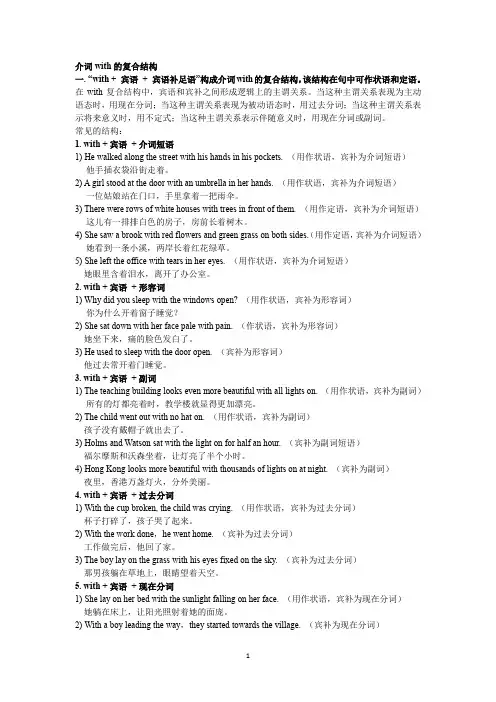
介词with的复合结构一. “with + 宾语+ 宾语补足语”构成介词with的复合结构,该结构在句中可作状语和定语。
在with复合结构中,宾语和宾补之间形成逻辑上的主谓关系。
当这种主谓关系表现为主动语态时,用现在分词;当这种主谓关系表现为被动语态时,用过去分词;当这种主谓关系表示将来意义时,用不定式;当这种主谓关系表示伴随意义时,用现在分词或副词。
常见的结构:1. with + 宾语+ 介词短语1) He walked along the street with his hands in his pockets. (用作状语,宾补为介词短语)他手插衣袋沿街走着。
2) A girl stood at the door with an umbrella in her hands. (用作状语,宾补为介词短语)一位姑娘站在门口,手里拿着一把雨伞。
3) There were rows of white houses with trees in front of them. (用作定语,宾补为介词短语)这儿有一排排白色的房子,房前长着树木。
4) She saw a brook with red flowers and green grass on both sides.(用作定语,宾补为介词短语)她看到一条小溪,两岸长着红花绿草。
5) She left the office with tears in her eyes. (用作状语,宾补为介词短语)她眼里含着泪水,离开了办公室。
2. with + 宾语+ 形容词1) Why did you sleep with the windows open? (用作状语,宾补为形容词)你为什么开着窗子睡觉?2) She sat down with her face pale with pain. (作状语,宾补为形容词)她坐下来,痛的脸色发白了。
3) He used to sleep with the door open. (宾补为形容词)他过去常开着门睡觉。

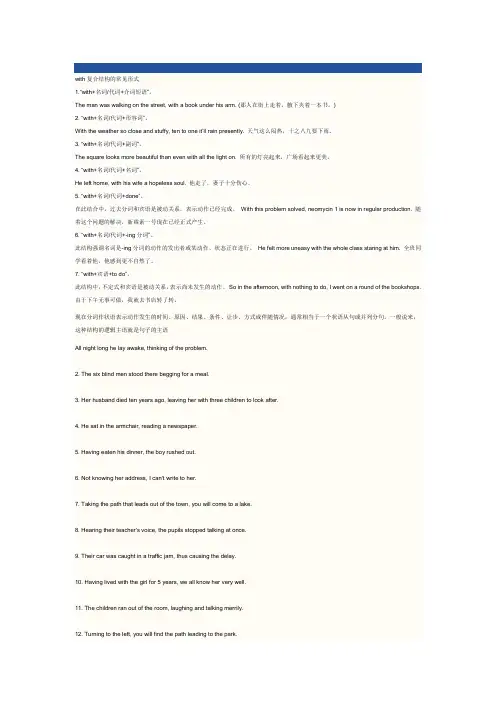
with复合结构的常见形式1.“with+名词/代词+介词短语”。
The man was walking on the street, with a book under his arm. (那人在街上走着,腋下夹着一本书。
)2. “with+名词/代词+形容词”。
With the weather so close and stuffy, ten to one it’ll rain presently. 天气这么闷热,十之八九要下雨。
3. “with+名词/代词+副词”。
The square looks more beautiful than even with all the light on. 所有的灯亮起来,广场看起来更美。
4. “with+名词/代词+名词”。
He left home, with his wife a hopeless soul. 他走了,妻子十分伤心。
5. “with+名词/代词+done”。
在此结合中,过去分词和宾语是被动关系,表示动作已经完成。
With this problem solved, neomycin 1 is now in regular production. 随着这个问题的解决,新霉素一号现在已经正式产生。
6. “with+名词/代词+-ing分词”。
此结构强调名词是-ing分词的动作的发出者或某动作、状态正在进行。
He felt more uneasy with the whole class staring at him. 全班同学看着他,他感到更不自然了。
7. “with+宾语+to do”。
此结构中,不定式和宾语是被动关系,表示尚未发生的动作。
So in the afternoon, with nothing to do, I went on a round of the bookshops. 由于下午无事可做,我就去书店转了转。
现在分词作状语表示动作发生的时间、原因、结果、条件、让步、方式或伴随情况,通常相当于一个状语从句或并列分句。
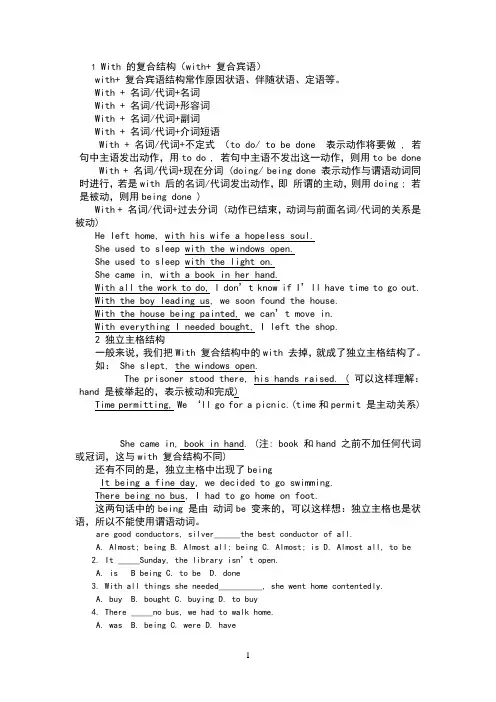
1 With 的复合结构(with+ 复合宾语)with+ 复合宾语结构常作原因状语、伴随状语、定语等。
With + 名词/代词+名词With + 名词/代词+形容词With + 名词/代词+副词With + 名词/代词+介词短语With + 名词/代词+不定式(to do/ to be done 表示动作将要做 , 若句中主语发出动作,用to do , 若句中主语不发出这一动作,则用to be done With + 名词/代词+现在分词 (doing/ being done 表示动作与谓语动词同时进行,若是with 后的名词/代词发出动作,即所谓的主动,则用doing ; 若是被动,则用being done )With + 名词/代词+过去分词 (动作已结束,动词与前面名词/代词的关系是被动)He left home, with his wife a hopeless soul.She used to sleep with the windows open.She used to sleep with the light on.She came in, with a book in her hand.With all the work to do, I don’t know if I’ll have time to go out.With the boy leading us, we soon found the house.With the house being painted, we can’t move in.With everything I needed bought, I left the shop.2 独立主格结构一般来说,我们把With 复合结构中的with 去掉,就成了独立主格结构了。
如: She slept, the windows open.The prisoner stood there, his hands raised. ( 可以这样理解:hand 是被举起的,表示被动和完成)Time permitting, We ‘ll go for a picnic.(time和permit 是主动关系)She came in, book in hand. (注: book 和hand 之前不加任何代词或冠词,这与with 复合结构不同)还有不同的是,独立主格中出现了beingIt being a fine day, we decided to go swimming.There being no bus, I had to go home on foot.这两句话中的being 是由动词be 变来的,可以这样想:独立主格也是状语,所以不能使用谓语动词。
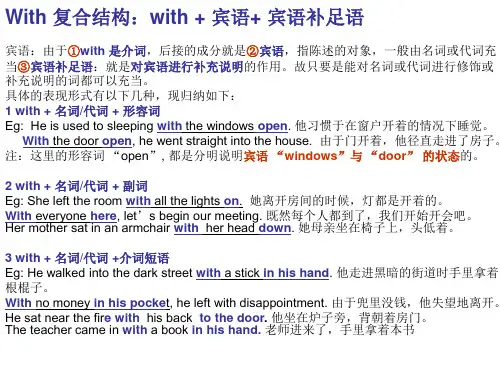

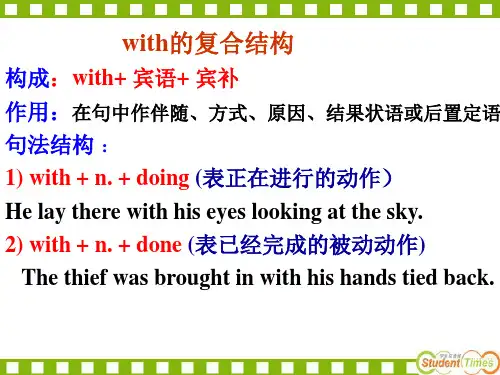
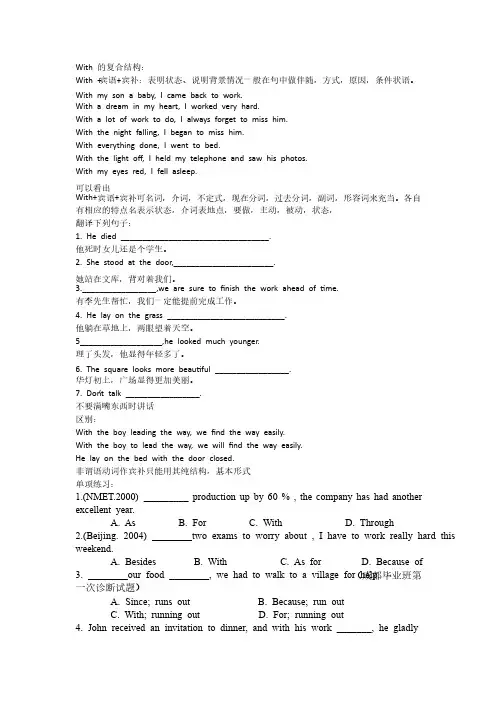
With 的复合结构:的复合结构:With +宾语+宾补:表明状态、说明背景情况一般在句中做伴随,方式,原因,条件状语。
宾补:表明状态、说明背景情况一般在句中做伴随,方式,原因,条件状语。
With my son a baby, I came back to work. With a dream in my heart, I worked very hard. With a lot of work to do, I always forget to miss him. With the night falling, I began to miss him. With everything done, I went to bed. With the light off, I held my telephone and saw his photos. With my eyes red, I fell asleep. 可以看出可以看出With+宾语+宾补可名词,介词,不定式,现在分词,过去分词,副词,形容词来充当。
各自有相应的特点名表示状态,介词表地点,要做,主动,被动,状态,有相应的特点名表示状态,介词表地点,要做,主动,被动,状态,翻译下列句子:翻译下列句子:1. He died __________________________________. 他死时女儿还是个学生。
他死时女儿还是个学生。
2. She stood at the door,_______________________. 她站在文库,背对着我们。
她站在文库,背对着我们。
3._________________,we are sure to finish the work ahead of me. 有李先生帮忙,我们一定能提前完成工作。
有李先生帮忙,我们一定能提前完成工作。
4. He lay on the grass ___________________________. 他躺在草地上,两眼望着天空。


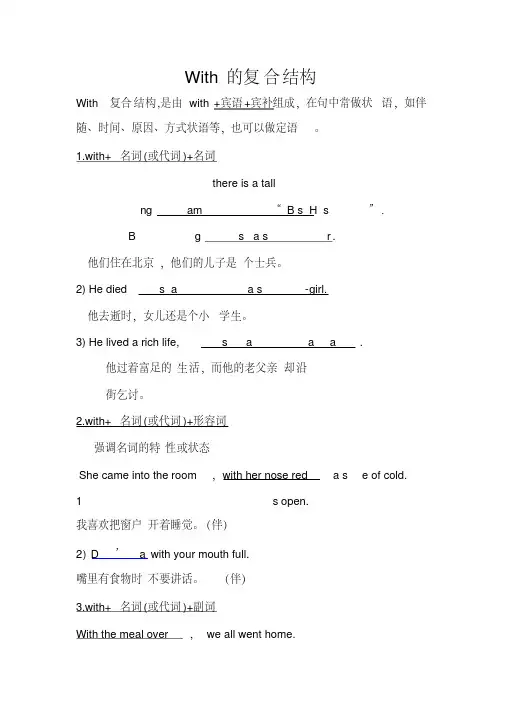
With的复合结构With复合结构,是由with+宾语+宾补组成,在句中常做状语,如伴随、时间、原因、方式状语等,也可以做定语。
1.with+名词(或代词)+名词there is a tallng am “B s H s ”.B g s a s r.他们住在北京,他们的儿子是个士兵。
2) He died s a a s -girl.他去逝时,女儿还是个小学生。
3) He lived a rich life, s a a a .他过着富足的生活,而他的老父亲却沿街乞讨。
2.with+名词(或代词)+形容词强调名词的特性或状态She came into the room,with her nose red a s e of cold.1s open.我喜欢把窗户开着睡觉。
(伴)2) D ’ a with your mouth full.嘴里有食物时不要讲话。
(伴)3.with+名词(或代词)+副词With the meal over ,we all went home.a with the light on.他睡着了,灯还亮着。
(伴)2) The boy stood there with his head down.这个男孩低头站在那儿。
(伴)4.with+名词(或代词)+介词短语Do you know the woman with a baby in her arms(=who has ababy in her arms)?a a a a a on when we want to.由于孩子们在上学,所以当我们想度假时而不能去度假。
(原)a a a a .士兵让他背朝着他的父亲站在那儿。
(方)5.with+名词(或代词)+动词不定式此时,不定式表示将发生的动作。
With the boy to lead the way,we will find the house easm ow.1) With no one to talk to, John felt upset.由于没人可以说话的人,约翰感到很焦虑。
1 With 的复合结构(with+ 复合宾语)with+ 复合宾语结构常作原因状语、伴随状语、定语等。
With + 名词/代词+名词With + 名词/代词+形容词With + 名词/代词+副词With + 名词/代词+介词短语With + 名词/代词+不定式(to do/ to be done 表示动作将要做, 若句中主语发出动作,用to do , 若句中主语不发出这一动作,则用to be doneWith + 名词/代词+现在分词(doing/ being done 表示动作与谓语动词同时进行,若是with 后的名词/代词发出动作,即所谓的主动,则用doing ; 若是被动,则用being done )With + 名词/代词+过去分词(动作已结束,动词与前面名词/代词的关系是被动) He left home, with his wife a hopeless soul.She used to sleep with the windows open.She used to sleep with the light on.She came in, with a book in her hand.With all the work to do, I don’t know if I’ll have time to go out.With the boy leading us, we soon found the house.With the house being painted, we can’t move in.With everything I needed bought, I left the shop.2 独立主格结构一般来说,我们把With 复合结构中的with 去掉,就成了独立主格结构了。
如:She slept, the windows open.The prisoner stood there, his hands raised. ( 可以这样理解:hand 是被举起的,表示被动和完成)Time permitting, We ‘ll go for a picnic.(time和permit 是主动关系)She came in, book in hand. (注: book 和hand 之前不加任何代词或冠词,这与with 复合结构不同)还有不同的是,独立主格中出现了beingIt being a fine day, we decided to go swimming.There being no bus, I had to go home on foot.这两句话中的being 是由动词be 变来的,可以这样想:独立主格也是状语,所以不能使用谓语动词。
With的复合结构
with+宾语+宾语补足语构成复合结构,宾语补足语根据逻辑意义可以是形容词、现在分词、过去分词、副词、介词短语、不定式等。
with复合结构在句中作状语。
结构如下:
①with+宾语+doing(doing表主动)
②with+宾语+adj.(adj.表状态)
③with+宾语+adv.
④with+宾语十done(done表完成和被动)
⑤with+宾语+介词短语
⑥with+宾语+to do(to do有时主动形式表示被动)
with的复合结构,是由with+复合宾语组成。
常在句中做状语,表示谓语动作发生的伴随情况、时间、原因、方式等。
其构成有下列几种情形:
1. with+宾语+doing(doing表主动)
此时,现在分词和前面的名词或代词是逻辑上的主谓关系。
例如:1)With prices going up so fast, we can't afford luxuries.
由于物价上涨很快,我们买不起高档商品。
(原因状语)
2)With the crowds cheering, they drove to the palace.
在人群的欢呼声中,他们驱车来到皇宫。
(伴随情况)
2. with+宾语十done(done表完成和被动)
此时,过去分词和前面的名词或代词是逻辑上的动宾关系。
例如:1)I sat in my room for a few minutes with my eyes fixed on the ceiling.
我在房间坐了一会儿,眼睛盯着天花板。
(伴随情况)
2)She had to walk home with her bike stolen.
自行车被偷,她只好步行回家。
(原因状语)
3. with+宾语+adj或者adv.(表状态)
例如:1)I like to sleep with the windows open.
我喜欢把窗户开着睡觉。
(伴随情况)
2)With the weather so cold and wet, we can’t go out for picnic today.
今天天气又冷又湿,我们不能出去野餐了。
(原因状语)
The boy stood there with his head down
4. with+宾语+介词短语
例如:1)With the children at school, we can't take our vacation when we want to.
由于孩子们在上学,所以当我们想度假时而不能去度假。
(原因状语)
2)The soldier had him stand with his back to his father.
士兵让他背朝着他的父亲站在那儿。
(行为方式)
5. with+宾语+to do不定式表示将发生的动作。
例如:1)With no one to talk to, John felt miserable.
由于没人可以说话的人,约翰感到很悲哀。
(原因状语)
2)With a lot of work to do, he wasn't allowed to go out.
因为还有很多工作要做,他没有被允许外出。
(原因状语)。